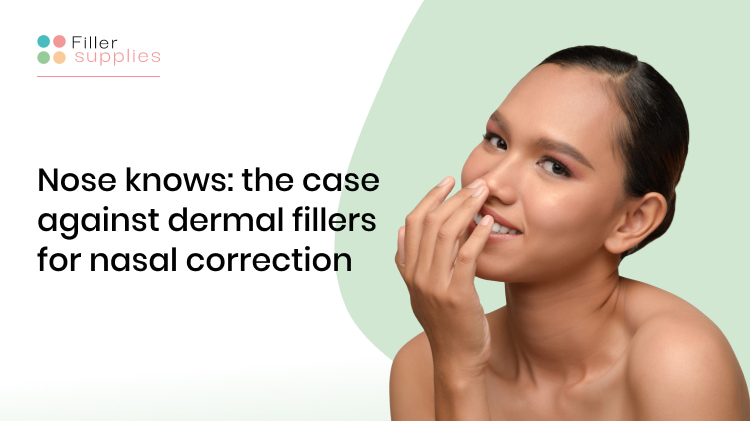Nose Knows: The Case Against Dermal Fillers for Nasal Correction

There is no doubt that dermal filler injections belong to the most advantageous aesthetic procedures these days. With their help, thousands of people worldwide substantially prolong their attractive and youthful appearance. Although the main indications for the usage of dermal fillers are wrinkle reduction, lip enhancement, and facial contouring, they are also sometimes used for a variety of other purposes, nasal correction (also known as non-surgical rhinoplasty) being one of them.
At the same time, many aesthetic specialists (such as cosmetologists, dermatologists, or plastic surgeons) speak against a non-surgical nose job performed with the help of dermal fillers. But why is it so? In this article, you will be able to check out 3 essential facts about the procedure that definitely have to be taken into account!
If you would like to buy dermal fillers online on the most advantageous terms, rely on FillerSupplies. Here, you will find a wide assortment of brand-name cosmetic injectables for affordable prices.
Definition of Dermal Fillers
Dermal fillers (also known as injectable fillers, facial fillers, or soft tissue fillers) are minimally invasive products intended for professional use. Their main aim is to create substantial facial rejuvenation and enhancement in a quick, safe, and effective way. Depending on the major active substance used in their composition, dermal fillers might be defined into the following types:
- Hyaluronic acid-based fillers;
- Calcium hydroxyapatite-based fillers;
- Poly-L-lactic acid-based fillers;
- And so on.
Moreover, each above-mentioned dermal filler type might be divided further in accordance with its main purpose. For instance, you might come across a hyaluronic acid facial filler, a hyaluronic acid lip filler, or a hyaluronic acid nose filler. Also, there exist universal fillers used for a variety of different purposes (starting from wrinkle reduction and ending with nose shape adjustment).
Contemporary aesthetic medicine offers a wide range of dermal filler brands. For example, Belotero, Fillmed, Juvederm, Restylane, Ellanse and Sculptra are the most popular hyaluronic acid-based dermal fillers.
Aesthetic Indications for Dermal Filler Injections
Using dermal fillers might help to take care of numerous aesthetic goals. When administered by an expert injector, they advantageously improve the overall appearance of a patient without creating any serious risks or causing adverse reactions. Starting from wrinkle reduction and ending with the so-called liquid rhinoplasty, dermal fillers function as effective alternatives to cosmetic surgery.
Wrinkle Reduction
According to most patients and their aesthetic doctors, wrinkle reduction is the most widespread aesthetic procedure that employs injectable fillers. These products do a great job when it comes to the enhancement of the skin by addressing nasolabial folds, marionette lines, crow’s feet, and other wrinkles all over the facial oval.
Lip Enhancement
Lip enhancement is also an aesthetic treatment frequently performed with the help of dermal fillers (or lip fillers, when being more precise). As healthcare providers (such as aesthetic doctor, a cosmetologist, or a dermatologist) mention, a professional injection of a lip filler might not only add volume to visually thin lips but also create an attractive and well-defined shape.
Facial Contouring
Furthermore, cosmetic procedures that create attractive facial contouring are also quite popular in the world of facial fillers. Namely, poorly defined chin, sunken cheeks, and asymmetrical facial oval are the common concerns of patients who would like to undergo an injection of dermal fillers. They are also the strategic points for an experienced practitioner who administers minimally invasive cosmetic solutions.
Other Indications
Apart from wrinkle reduction, lip enhancement, and facial contouring, dermal fillers might also be used for a number of other aesthetic indications. For instance, a substantial number of patients prefer to use them to correct such nasal imperfections as an aquiline nose of a drooping nasal tip. This correction is usually referred to as a nose filler rhinoplasty.
Unlike a rhinoplasty surgery, nonsurgical rhinoplasty cannot create permanent results. Depending on the individual peculiarities of each patient, it might last from several months to a couple of years.
3 Facts to Know About Dermal Fillers vs. Nasal Correction (Non-Surgical Rhinoplasty)
Despite their high popularity, non-surgical rhinoplasties have achieved a lot of criticism from both healthcare providers and treated patients. Below, you will find top 3 facts worth paying attention to while deciding whether to undergo a procedure of nose reshaping with nose fillers or look for a different way of nasal correction.
#1. Potential Risks of Non-Surgical Nose Fillers
While effectively addressing a bulbous nose, a saddle nose, or a crooked nose, non-surgical nose job with the help of cosmetic fillers carries a number of potential risks. Especially when performed in an unprofessional way, it might not only cause injection site irritation, but also can lead to such serious problems as skin necrosis, vascular occlusion (and other vascular complications), tissue death, and even vision loss.
#2. Non-Permanent Duration of the Results After a Non-Surgical Rhinoplasty
Non-surgical rhinoplasty cannot change the appearance of the nose forever (unlike plastic surgery). The main reason for it is that the vast majority of cosmetic fillers used for nose job are the non-permanent fillers and, therefore, their results fade away with time. On average, they last about one year (unless prolonged by periodical follow-up treatments).
#3. Realistic Results
In the majority of cases, non-surgical rhinoplasty is used to correct minor irregularities in the shape of the nose (for instance, to create a straight line of the nose bridge or enhance the outlook of the nasal tip). A great number of patients who have already had previous surgical rhinoplasty claim its results to be way more visible than the ones after a non-surgical nose job.
An informed consent of a patient is an essential precondition for a successful nonsurgical rhinoplasty. Thus, it is of vital importance to stay informed of potential pitfalls of nose filler treatments.
A Bottom Line
All in all, nasal correction with the help of dermal fillers is a popular treatment that requires minimal preparation and recovery time. For this reason, such nose job is exceptionally popular these days. However, there exists a number of facts that speak against rhinoplasty with the help of cosmetic fillers. Hopefully, this article has helped you to get well-aware of them.
Post Scriptum
Nasal correction with the help of cosmetic fillers is a procedure intended exclusively for professional use. For this reason, only a certified healthcare provider (such as a dermatologist, a cosmetologist, or a plastic surgeon) with respective qualification is eligible to perform the treatment (regardless of whether he or she aims to work with the whole nose or just its tip).
Since the result of the treatment strongly depends on the proficiency of the healthcare provider, it is of vital importance to find the one you could rely on. Thus, always check the photo gallery of a dermatologist, cosmetologist, or plastic surgeon before scheduling the procedure with him or her. Remember, your well-being is the highest priority you should have!

